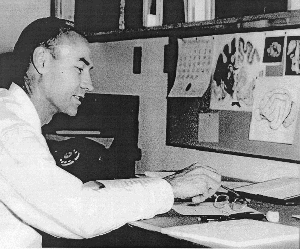Roger Sperry
From Psy3242
Beginnings in Education
Roger Sperry was born in Hartford, Connecticut and grew up on a farm. He excelled athletically and academically, eventually matriculating at Oberlin College in Ohio, where he would compete in four varsity sports and graduate with an English degree. Sperry then obtained his Master’s degree in psychology and went on to pursue a Ph.D. in zoology at the University of Chicago, where he would eventually become a faculty member. In 1951, Sperry presented his work on neurospecificity to the California Institute of Technology and obtained the Hixon Professorship of Psychobiology. He joined the faculty at Caltech in 1954 and remained a faculty member there for the rest of his life.
Sperry at work in a lab in his youth
Disproving Paul Weiss
His first major work revolved around disproving a theory that originated from Paul Weiss, who was not only an infamous biologist at the time, but one of Sperry’s own previous professors at the University of Chicago. Weiss believed that our neural networks developed from an otherwise unspecified mass of undifferentiated nerve fibers, which rely on plasticity and interchangeability as the main factors for development. However, experimental surgical procedures on fish, salamanders, monkeys, and other animals allowed Sperry to show that the circuits of the brain are actually geared towards specific functions very early in embryonic development, which remain fixed thereafter. In his experiments, Sperry would demonstrate the specific nature of nerve connections by, for instance, redirecting the left and right foot pathways in a rat (the rat would move its left foot when trying to move its right foot, etc.). After extensive observation, Sperry noted that no amount of experience allowed the animal’s neural network to rearrange.
In yet another experiment, Sperry severed the optic nerves of frogs and salamanders (animals known for good regeneration), then rotate the eye in the socket and wait for the nerves to grow back. What he found was that after the severed neural network healed, the animal still saw upside down and backwards, and no amount of experience brought it back to equilibrium. These experiments gave birth to a new field of research in “axonal guidance,” which tries to answer questions about the basis of learning on the cellular level.
Nobel Prize Achievement
His work that was awarded the Nobel Prize in 1981 however, concerned research on split brain patients. Once again, Sperry went against the popular opinion of the time that severing the corpus callosum would produce no major behavioral results. Through the use of innovative testing techniques, Sperry demonstrated that by performing a corpus callosotomy, the information transfer between left and right brain hemispheres ceases, giving rise to two coexisting, yet functionally distinct brain halves.
Researchers before Sperry had not realized this because the two halves receive the same sensory input for the most part, and consequently react in a similar fashion, making it appear as if nothing was different. Using specifically designed tests for split brain patients, Sperry showed that each half is in fact a conscious entity in its own right. His research proved and disproved certain theories concerning hemispheric functionalities that had been argued over for years.

